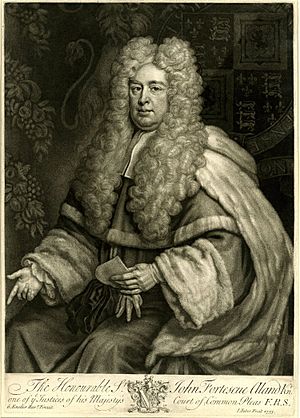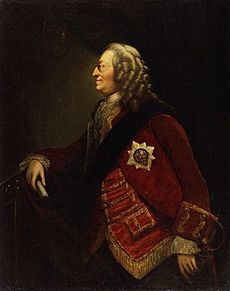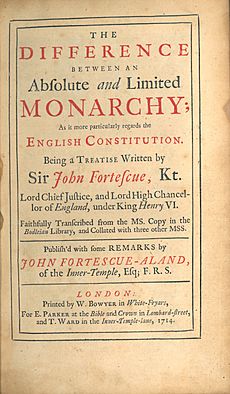John Fortescue Aland, 1st Baron Fortescue of Credan facts for kids
Quick facts for kids
Sir
John Fortescue Aland, 1st Baron Fortescue of Credan
D.C.L., F.R.S.
|
|
|---|---|

A mezzotint of Fortescue Aland by John Faber the Younger, after a portrait by Sir Godfrey Kneller, in the collection of the British Museum. Dated 1733, this portrait was completed in the subject's lifetime.
|
|
| Baron of the Exchequer | |
| In office 24 January 1717 – Michaelmas term 1718 |
|
| Justice of the Court of King's Bench | |
| In office Michaelmas term 1718 – 10 June 1727 (day before George II's accession) |
|
| Justice of the Court of Common Pleas | |
| In office 27 January 1728 – Trinity term 1746 |
|
| Personal details | |
| Born |
John Fortescue
7 March 1670 England |
| Died | 19 December 1746 (aged 76) England |
| Resting place | St Mary the Virgin, Stapleford Abbotts, Essex, England 51°38′37.9″N 0°10′4.01″E / 51.643861°N 0.1677806°E |
| Political party | Whigs |
| Spouses | Grace Pratt (c. 1707), Elizabeth Dormer (29 December 1721) |
| Children | Dormer Fortescue Aland, 2nd Baron Fortescue of Credan, and five others |
John Fortescue Aland (born March 7, 1670 – died December 19, 1746) was an important English lawyer, judge, and politician. He lived in Stapleford Abbotts, Essex. He served in the House of Commons, which is like a parliament, for two years.
Fortescue Aland also wrote books about English law and how the government works. Some people believe his writings even influenced Thomas Jefferson, one of America's Founding Fathers. He was a member of important legal groups called the Middle Temple and Inner Temple. He became a top lawyer, known as a King's Counsel, in 1714.
He then became the Solicitor General, first for the Prince of Wales (who later became King George II) and then for his father, King George I. After his time in parliament, he became a judge. He was a Baron of the Exchequer in 1717. Later, he served as a judge in the Court of King's Bench (1718–1727) and the Court of Common Pleas (1728–1746). There was a short time when he wasn't a judge, possibly because King George II didn't like one of his legal opinions.
In 1714, Fortescue Aland published a book called The Difference between an Absolute and Limited Government. This book was based on an old manuscript by his ancestor, Sir John Fortescue. Many believe this was the first book in English about how a country's government and laws are formed. Thomas Jefferson later referred to Fortescue Aland's ideas from this book.
Contents
Early Life and Education
John Fortescue Aland was born on March 7, 1670. He was the second son of Edmund Fortescue and Sarah Aland. His mother's family was from County Waterford, Ireland.
In 1704, he inherited property from his mother's side after his older brother died. Because of this, he added "Aland" to his last name.
It's not fully clear where he went to school. However, he started studying law at the Middle Temple in 1688. He officially became a lawyer, or was "called to the Bar", in 1695. Later, he joined the Inner Temple in 1712 and became a "bencher" there in 1716. A bencher is a senior member of one of the Inns of Court, which are professional associations for barristers in England.
Legal and Political Career

Fortescue Aland was chosen as a Fellow of the Royal Society on March 20, 1712. This is a very old and famous group for scientists. In 1714, he became a King's Counsel, which means he was a very senior lawyer who advised the King.
He was appointed Solicitor General first to the Prince of Wales (who became King George II) in October 1714. Then, in December 1715, he became Solicitor General to King George I. He took over from his father-in-law, Sir John Pratt.
Fortescue Aland was elected as a Whig Member of Parliament for Midhurst in the 1715 general election. He didn't have anyone running against him. He left his seat in parliament when he became a judge. He was made a Baron of the Exchequer and knighted on January 24, 1717.
He served as a judge in the Court of King's Bench from 1718 to 1727. Then, he was a judge in the Court of Common Pleas from 1728 until 1746.
Why Was He Removed as a Judge?
When King George I died and his son became King George II on June 11, 1727, Fortescue Aland was not immediately reappointed as a judge. This meant he was removed from his position. One reason for this might have been his answer to a question King George I had asked the courts.
The King and the Prince of Wales (who became George II) had a disagreement. The King wanted to know if he had the right to decide about the education and marriages of his grandchildren. Fortescue Aland was one of ten judges who agreed that King George I did have this right.
When George II became King, Fortescue Aland was worried that his opinion might have upset the new King. He wrote to a friend, asking for help to get his job back. He reminded them that George II had approved of his work before.

However, some people, like William Tooke, doubted that George II would remove a judge just for giving an honest legal opinion. They thought George II was fair. In any case, Fortescue Aland was reinstated as a judge on January 27, 1728. This was the last time a judge was not reappointed when a new king or queen came to the throne.
In 1733, the University of Oxford gave Fortescue Aland an honorary degree called a Doctor of Civil Law (D.C.L.). This showed how respected he was. Writers like Francis Gregor and George Hicks said he was a very good judge who knew a lot about old English laws and literature.
Fortescue Aland retired as a judge in 1746 when he was 76 years old. He had served as a judge for about 30 years. After his retirement, he was given a special title: Baron Fortescue of Credan. This made him a "peer" in the Peerage of Ireland. He died four months later, on December 19, 1746.
Publications and Influence
In 1714, Fortescue Aland published The Difference between an Absolute and Limited Monarchy. This book was based on an old manuscript found in the Bodleian Library. It was written by his ancestor, Sir John Fortescue, who lived much earlier (around 1394 – c. 1480). Fortescue Aland added his own thoughts in a long introduction. This book is thought to be the first English work about how a country's government and laws are formed.
After his death, a collection of court decisions that Fortescue Aland had put together was published in 1748. It was called Reports of Select Cases in All the Courts of Westminster-Hall.
Thomas Jefferson, a key figure in American history, read the 1719 edition of The Difference between an Absolute and Limited Monarchy. He liked Fortescue Aland's idea that lawyers should study Anglo-Saxon history. Later, in 1814, Jefferson praised Fortescue Aland's knowledge when writing to Thomas Cooper.
Family Life
Around 1707, Fortescue Aland married Grace Pratt. She was the daughter of Sir John Pratt, who was a very important judge. Sadly, all five of their children died before him.
After Grace passed away, Fortescue Aland married Elizabeth Dormer on December 29, 1721. She was the daughter of Robert Dormer, who was also a judge. They had one son named Dormer. Dormer became the second Baron Fortescue of Credan after his father's death.
Fortescue Aland was buried in the church of St Mary the Virgin in Stapleford Abbotts, Essex. His second wife was later buried next to him. Their son, Dormer, died unmarried in 1780. This meant that the Fortescue Aland family line and their special title ended. Their properties then went to the heir of Earl Clinton.
The family's coat of arms was described as: a blue shield with a silver "bend" (a diagonal stripe) that had wavy edges and was outlined in gold. The crest was a plain silver shield. The supporters were two silver greyhounds with red collars and leashes. Their motto was "Forte scutum salus ducum", which means "A strong shield is the salvation of leaders."



